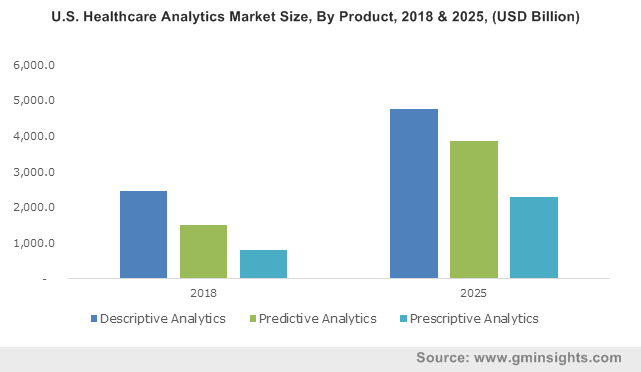U.S. healthcare analytics market to observe rapid expansion over the coming years, hospitals to be the prominent technology end-users
Publisher : Fractovia | Published Date : 2017-05-26Request Sample
Healthcare analytics market is witnessing a phenomenon of sorts, with the increasing number of remote consultations and monitoring practices across the globe. The surging adoption of smart phones and tablets will favorably attribute the product demand across myriad medical application arenas such as financial, clinical, and operations management. Growing emergence of electronic devices in the medical sector to maintain electronic records of patients will stimulate healthcare analytics industry. Additionally, the penetration of IoT and the emerging software based technological developments will contribute significantly toward the industry growth. As per the report by Global Market Insights, Inc., “Healthcare analytics market having had a revenue of USD 5.5 billion in 2016, will collect a significant revenue of more than USD 16 billion with an annual growth rate exceeding 12% over the period of 2017 to 2024.”
U.S. dominated the North America healthcare analytics market in 2016 by contributing to more than 90% of the total regional revenue share. The growth can be attributed to the growing acceptance of electronic based health record systems across healthcare sector. Moreover, adoption of advanced technology and the existence of a high-grade healthcare infrastructure will also stimulate the product demand. The U.S. houses most of key industry players contributing to global business growth, which is a crucial factor impacting regional healthcare analytics market share.
Germany Healthcare Analytics Market Size, By Product, 2013-2024 (USD Million)

Hospitals dominated the end use segment of healthcare analytics market by accounting about 70% total revenue share in 2016 and will generate considerable revenue by 2024, growing at an annual growth rate of more than 12% over the period of 2017 to 2024. The implementation of analytics software in hospitals will help to reduce fraud and errors in payments, provide efficient patient-physician coordination and minimize the total administrative cost.
Japan healthcare analytics market was valued more than USD 240 million in 2016 and will record a steep growth rate of 12% over the coming years of 2017 to 2024. Favorable initiations undertaken to control the increasing medical costs along with the availability of advanced healthcare IT services will contribute toward the regional industry growth. Of late, most of the hospitals across Japan are implementing prescriptive and predictive analytics.
Prescriptive analytics product segment of healthcare analytics industry will record an annual growth rate of 14% over the coming years of 2017 to 2024, primarily driven by the ability of the product to provide the best possible outcomes and suggest effective ways to combat the aftereffects of these outcomes on the overall business metrics. Industry giants have been investing heavily to reduce the complexity of prescriptive analytics. Noteworthy participants in healthcare analytics market are OptumHealth, IBM, Allscripts Healthcare Solutions, McKesson Corporation, Inovalon, Cerner Corporation, Computer Programs and Systems, Inc., Athenahealth, Tenet Healthcare Corporation, Health Catalyst, Evolent Health, Change Healthcare, GE Healthcare, and Influence Health.
Healthcare analytics market share from clinics will surpass a revenue collection of USD 2 billion by 2024 with a CAGR of more than 13% over the coming seven years. Growing adoption of primary care analytics will help to reduce the total expenditure on the healthcare data and enhance the healthcare services, which will suitably augment the industry growth.
Financial management covered more than 30% of the revenue share in application segment of healthcare analytics market and will generate a revenue of more than USD 5.5 billion by 2024. This product offers benefits in terms of cost effectiveness and helps to retain qualitative healthcare data of patients. The ability of the product to reduce the financial frauds will also influence healthcare analytics industry value notably.
Pertaining to the product landscape of healthcare analytics market, descriptive analytics led the industry by accounting for more than 55% of the overall revenue contribution in 2016 and will exhibit a CAGR of more than 11% over the period of 2017 to 2024.
The notable growth tactics adopted by leading industry players include strategic partnerships, acquisitions, collaborations, and product differentiation to expand their business across the globe over the years ahead.